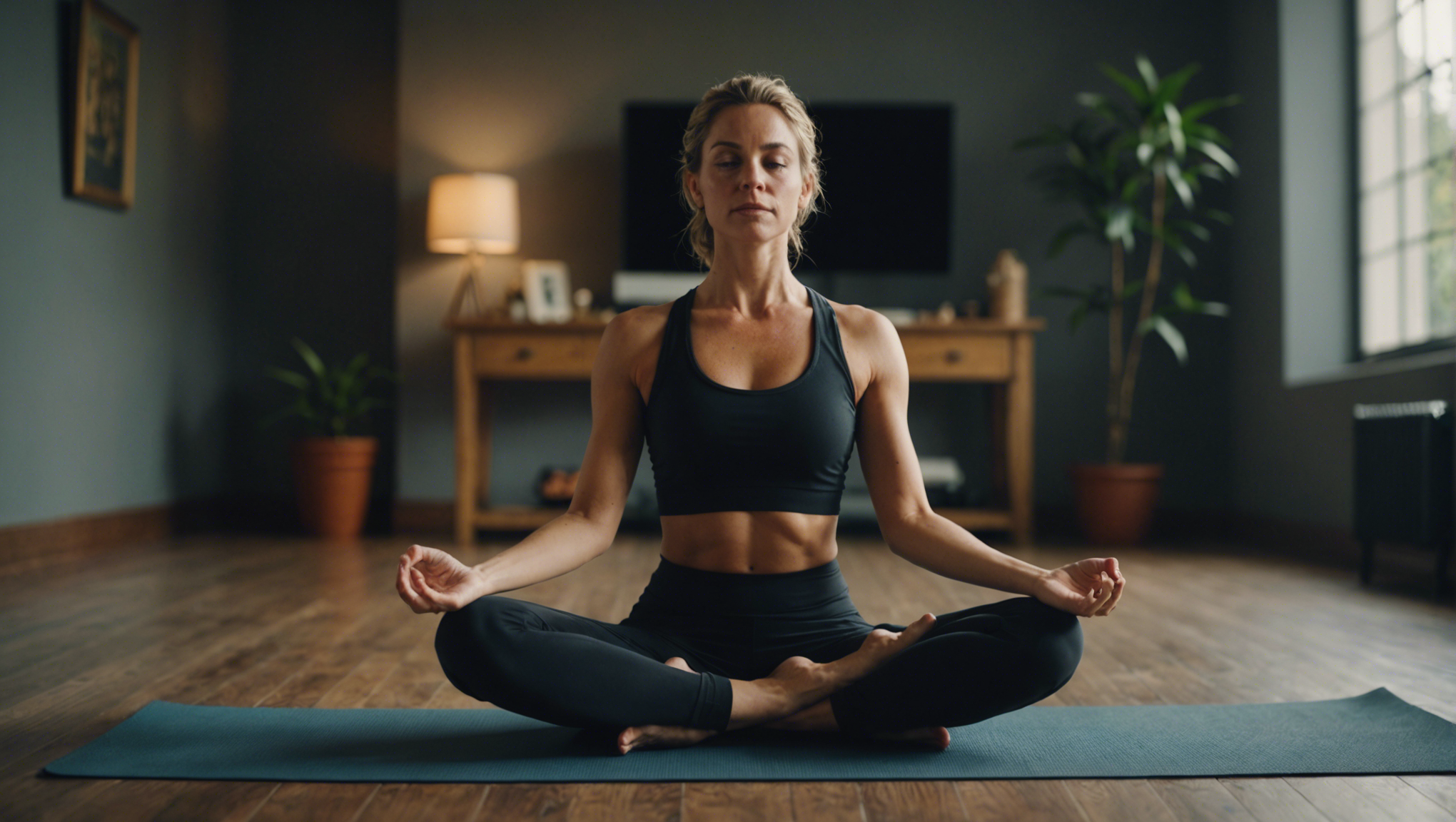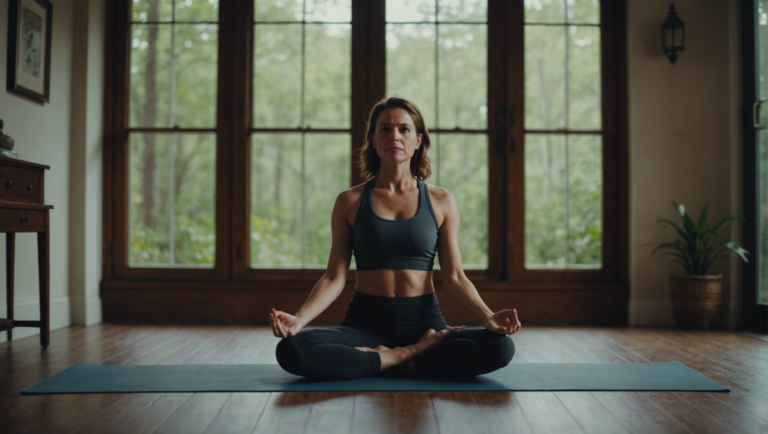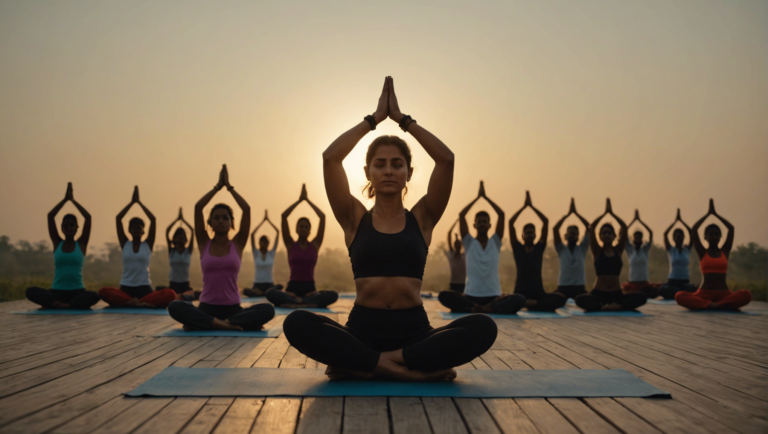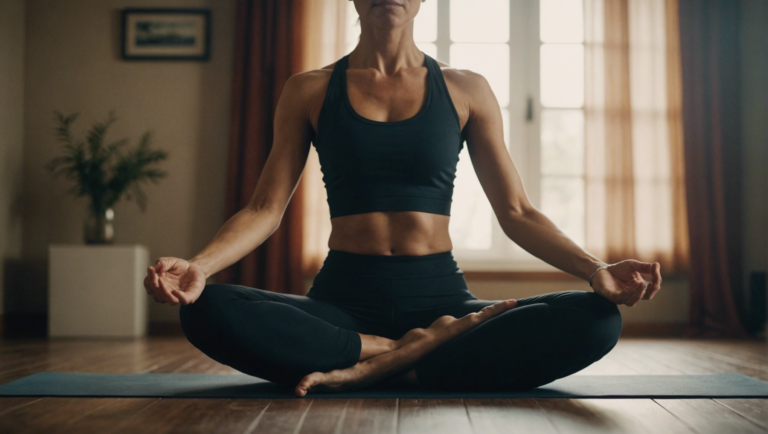Discovering The Best Yoga Practices For Anxiety Relief
Discovering the Best Yoga Practices for Anxiety Relief
Understanding Yoga’s Role in Easing Anxiety
With over two decades of experience in the health and wellness sector, I’ve witnessed the transformative power of yoga in the lives of people grappling with anxiety. Yoga, a mind-body practice rooted in ancient philosophy, offers a multifaceted approach to relieving anxiety, merging physical postures, breath work, and meditation to foster a state of balance and peace.
The Science Behind Yoga and Anxiety Relief
Research substantiates the claim that yoga can act as a potent antidote to anxiety. By engaging in regular yoga practice, individuals may experience a reduction in stress hormone levels, an enhancement in mood, and an improved overall sense of well-being. This is attributed to yoga’s ability to activate the parasympathetic nervous system, the part of the autonomic nervous system that oversees relaxation and recovery.
Selecting the Right Yoga Style for You
When exploring yoga as a tool for anxiety relief, it’s crucial to find a style that resonates with you personally. There are various forms of yoga, each with its unique focus and benefits.
-
Hatha Yoga: Known for its slower pace, Hatha yoga is ideal for beginners. It focuses on static postures and breath control, facilitating a deeper connection between mind and body.
-
Vinyasa Yoga: This style is more dynamic, linking breath with movement in a flow-like sequence. Vinyasa is excellent for those who seek a more physical practice, aiding in the release of pent-up energy and stress.
-
Yin Yoga: With an emphasis on passive stretching, Yin yoga targets the deep connective tissues of the body. Holding poses for longer periods promotes relaxation and can be especially beneficial for those with heightened anxiety.
-
Restorative Yoga: As the name suggests, Restorative yoga is all about relaxation and healing. Through the use of props, practitioners are supported in poses for extended durations, allowing the body to naturally release tension.
Essential Yoga Poses for Anxiety Relief
Integrating specific yoga poses into your routine can significantly impact your ability to manage anxiety. Here are a few poses renowned for their calming effects:
-
Child’s Pose (Balasana): A grounding pose that promotes a sense of safety and comfort, ideal for moments of heightened anxiety.
-
Legs-Up-The-Wall Pose (Viparita Karani): This restorative pose helps to calm the nervous system and can be particularly soothing before bedtime.
-
Seated Forward Bend (Paschimottanasana): Encourages focus and introspection while stretching the back and aiding in stress relief.
-
Corpse Pose (Savasana): Although it may appear simple, Savasana is a profound pose for deep relaxation and meditation, essential for concluding a yoga session.
Integrating Breath Work and Meditation
Beyond physical poses, the practice of controlled breathing (pranayama) and meditation are vital components of yoga for anxiety management. Techniques such as deep abdominal breathing can help lower stress responses and bring about a sense of calm. Meditation, particularly mindfulness meditation, trains the mind to stay present, reducing the propensity to ruminate on past or future worries.
Creating a Sustainable Practice
For yoga to be genuinely effective in combating anxiety, consistency is key. Start with short, daily sessions and gradually build up as you become more comfortable. Remember, it’s not about perfection but progression. Finding a qualified instructor or class that emphasizes anxiety relief can also be incredibly supportive.
The Path Forward
Embarking on a yoga journey offers more than just temporary relief from anxiety; it cultivates tools for resilience and emotional regulation that are invaluable in navigating life’s challenges. By embracing yoga, you commit to a practice of self-exploration and healing, unlocking a path to a more tranquil and balanced existence.
The Science Behind Yoga and Its Impact on Mental Health
Yoga, an ancient practice with its roots deeply embedded in Indian philosophy, has traversed beyond its initial spiritual realm to take a significant place in health and wellness, especially focusing on mental health. The practice, a harmonious blend of physical postures, breathing techniques, and meditation or relaxation, has been scientifically linked to numerous mental health benefits. Below, we delve into the nexus between yoga and its salutary effects on mental well-being, exploring the depth of research and evidence supporting this connection.
The Interplay between Yoga and Stress Reduction
Yoga’s role in mitigating stress stands as one of the most well-documented benefits, with numerous studies highlighting how yoga practice can decrease the secretion of cortisol, the body’s primary stress hormone. This reduction in cortisol levels fosters a state of relaxation and reduces subjective feelings of stress, making yoga an effective non-pharmacological strategy for stress management.
Enhancing Mood and Alleviating Anxiety
Regular yoga practice has been shown to significantly improve mood and reduce symptoms of anxiety. The mechanisms underlying this are multifaceted, including the promotion of relaxation through deep breathing exercises, which can lower heart rate and blood pressure, and the encouragement of a mindful state, which enables practitioners to stay present and detached from stress-inducing thoughts.
Yoga’s Impact on Depression
Yoga’s efficacy extends to the domain of depression, with various studies corroborating its role in diminishing depressive symptoms. By fostering an increase in serotonin levels, often referred to as the happiness hormone, and enhancing the activity in areas of the brain responsible for mood regulation, yoga offers a promising complementary treatment for depression.
Improving Sleep Quality
The tranquilizing effect of yoga on the mind extends to improvements in sleep quality. Insomnia and other sleep disturbances are commonly associated with mental health issues such as anxiety and depression. Yoga, particularly practices like Yoga Nidra, which emphasizes relaxation, can significantly improve sleep patterns, thereby contributing to overall mental well-being.
Cognitive Benefits of Regular Yoga Practice
Beyond the emotional benefits, engaging in yoga has been linked to enhancements in cognitive functions. Practices that integrate physical postures with mindful attention and concentration can lead to improvements in memory, executive function, and attention span. This cognitive boost not only contributes to mental health by reducing stress and anxiety but also enhances day-to-day functioning and productivity.
The Therapeutic Potential of Yoga in Mental Health Care
Given its broad spectrum of benefits, yoga is increasingly being recognized as a valuable tool in mental health care. Mental health professionals are beginning to incorporate yoga practices as part of treatment plans for patients dealing with anxiety, depression, PTSD, and stress-related disorders. This integration underscores the growing acceptance of yoga not just as a physical wellness practice but as a comprehensive approach to mental health care.
A Call to Action for Holistic Health
The burgeoning body of research advocating for yoga’s mental health benefits serves not only as a testament to its efficacy but also as a call to action for individuals and healthcare providers to adopt a more holistic approach to health. yoga into daily routines can be a powerful strategy for enhancing mental well-being and mitigating the impacts of stress and mental health conditions.
Yoga, with its rich tradition and evolving practice, stands at the confluence of physical, mental, and emotional health. The science backing its benefits for mental well-being is robust, rendering it a critical component of a holistic approach to health care. As research continues to unfold, the potential of yoga in fostering mental health and resilience becomes ever more clear, offering a promising pathway for those seeking tranquility and balance in today’s fast-paced world.
Personalizing Your Yoga Routine for Maximum Anxiety Reduction
In an age where anxiety seems to be a common thread weaving through the fabric of society, finding solace and calm becomes a priority for many. Yoga, known for its myriad benefits both physical and mental, emerges as a beacon of hope. Personalizing one’s yoga routine can amplify its anxiety-reducing power, turning a general practice into a tailored sanctuary of peace. Below are steps designed to guide you through crafting a yoga routine that resonates deeply with your individual needs for maximum anxiety reduction.
Tailor Your Practice to Your Current Emotional State
Understanding your emotional needs is the first step in customizing your yoga routine. Anxiety can manifest in various forms – from a restless mind to a fatigued body. Begin by acknowledging how your anxiety speaks to you. Is it a storm of thoughts in your mind, or perhaps a heavy sensation in your body? Identifying this will help you choose yoga poses (asanas) that specifically address those manifestations. For mental turmoil, meditative poses and breathing-focused practices (pranayama) offer great relief. Physical tension, on the other hand, may find solace in more dynamic movements that release stored energy.
Embrace the Power of Breathwork
Pranayama, or yogic breathing, is a cornerstone of reducing anxiety through yoga. Specific breathing techniques, such as Ujjayi (the Ocean Breath), Anulom Vilom (Alternate Nostril Breathing), and Bhramari (the Bee Breath), have profound calming effects on the nervous system. These practices help center your mind, bring awareness to the present, and detach from cyclical anxious thoughts. Integrating pranayama at the beginning, middle, and end of your yoga session can significantly enhance the tranquility experienced during and after your practice.
Integrate Mindfulness and Meditation
Expanding your practice beyond physical postures to include mindfulness and meditation deepens the anxiety-reducing benefits of yoga. Mindfulness encourages a state of active, open attention to the present moment and can be woven into your yoga routine through conscious movement and breath awareness. Following your yoga practice with a short meditation, even just five minutes, can consolidate the peace and stillness you’ve cultivated, allowing your mind to rest deeply in a state of serenity.
Seek Poses That Foster Inner Calm
Certain yoga poses have a direct effect on the body’s stress response, promoting a sense of tranquility. Forward bends, for instance, are known for their soothing effect on the mind, making them ideal for counteracting anxiety. Child’s Pose (Balasana), Standing Forward Bend (Uttanasana), and Legs-Up-The-Wall Pose (Viparita Karani) are excellent choices that encourage a sense of safety and withdrawal from external stressors. these asanas into your routine can provide a comforting retreat for the mind.
Create a Conducive Environment
Setting plays a crucial role in the effectiveness of your yoga practice, especially when tailored for anxiety reduction. Choose a serene, comfortable space where you won’t be disturbed. Soft lighting, perhaps the glow of candles or diffused natural light, can create a soothing ambiance. Consider adding elements such as calming music or nature sounds, and perhaps aromatherapy with essential oils like lavender or chamomile to enhance the sensory experience and further soothe the mind.
Listen to Your Body and Mind
Remember, the goal of personalizing your yoga routine is to meet yourself where you are, with kindness and acceptance. Some days, your body and mind may crave gentle, restorative practices; on others, you might find more dynamic flows beneficial. Continuously tuning into your current state and adjusting your practice accordingly ensures your yoga journey remains aligned with your evolving needs for anxiety relief.
By adopting these steps into your daily routine, yoga can transcend being simply a physical exercise to become a deeply personal practice of self-care. It provides not only a refuge from the storms of anxiety but also a path toward enduring peace and resilience.
Integrating Mindfulness and Meditation into Yoga for Enhanced Calm
Yoga, an ancient practice rooted in Indian philosophy, has long been acclaimed for its physical, mental, and spiritual benefits. Today, in a world rife with anxiety and stress, yoga’s holistic approach offers not just a method of fitness, but a path to inner peace. The integration of mindfulness and meditation into yoga practice amplifies its calming effects, creating an oasis of tranquility in our hectic lives. This guide delves into the synergy of yoga with mindfulness and meditation for enhanced calm, drawing from centuries-old wisdom to help navigate the modern world’s turmoil.
Crafting a Foundation of Mindfulness in Yoga
Mindfulness, the practice of being fully present and engaged in the moment without judgment, is the cornerstone of a more serene yoga practice. By focusing on the breath and bodily sensations during each pose, practitioners can anchor themselves in the present, reducing anxiety and stress. This mindful approach turns each movement and breath into a meditative act, deepening the yoga experience beyond physical exercise to a form of moving meditation.
The Role of Meditation in Deepening Yoga Practice
Meditation, often practiced independently, finds a powerful complement in yoga. When these disciplines converge, they create a symbiotic relationship that enriches both the mind and body. Establishing a meditation practice within yoga involves dedicating portions of the session to stillness and introspection, guiding the mind to a state of peaceful awareness. This meditative focus throughout a yoga practice can help in disengaging from the chatter of the mind, offering profound layers of relaxation and insight.
Techniques for Integrating Mindfulness and Meditation into Yoga
Embarking on this integrated path requires intentional practice and patience. Here are several techniques to enrich your yoga practice with mindfulness and meditation:
- Begin with Breath Awareness: Prioritize breath control (pranayama) at the start of your session to cultivate an immediate sense of presence and focus.
- Set an Intention: At the beginning of your practice, set an intention (sankalpa) as a guiding light for your meditation and mindfulness journey.
- Embrace Slow Movements: Opt for slower yoga styles like Hatha or Yin, allowing ample time to observe and connect with each movement mindfully.
- Incorporate Silent Reflection: Dedicate time at the end of your practice for silent meditation, absorbing the effects of your physical efforts and grounding your mind in calmness.
- Practice Yoga Nidra: Integrate Yoga Nidra—a form of guided meditation performed in a lying position—at the conclusion of your practice for deep relaxation and mental clarity.
Navigating Challenges and Deepening Your Practice
The journey of blending yoga with mindfulness and meditation may present challenges, such as difficulty maintaining focus or encountering mental discomfort. Embrace these challenges as opportunities for growth, employing patience and self-compassion as you navigate your inner landscape. Remember, the journey itself is the goal, and every moment of mindfulness or meditation enriches your practice, offering gateways to increasingly profound levels of peacefulness and self-awareness.
The Transformative Impact of a Mindful and Meditative Yoga Practice
Embracing yoga as a holistic, mindful, and meditative practice has transformative potential. Beyond its capacity to ameliorate stress and anxiety, it fosters a deep-seated equilibrium, harmonizing body, mind, and spirit. This integrated approach cultivates a resilient inner calm, empowering practitioners to face life’s adversities with equanimity and grace.
In the embrace of yoga, mindfulness, and meditation, we find a comprehensive toolkit for navigating the complexities of modern life with greater calm and clarity. This harmonious fusion not only enhances personal well-being but also contributes to a more mindful, compassionate world, one breath, one pose, one moment at a time.
Overcoming Common Challenges in Starting a Yoga Practice for Anxiety Management
Embracing a new yoga practice specifically for anxiety management can be a transformative journey towards achieving a calmer mind and a more centered being. However, starting on this path often comes with its own set of challenges. Recognizing and overcoming these hurdles is crucial for a successful integration of yoga into one’s lifestyle for effective anxiety relief. This article dives into practical steps to navigate the common obstacles encountered during the early stages of establishing a yoga routine aimed at managing anxiety.
Navigating Time Constraints
Finding Time in a Busy Schedule
One of the primary challenges individuals face is carving out time in their already packed schedules. Yoga requires consistency, but this doesn’t mean hours each day need to be dedicated to practice. The key is to start small—just 10 to 15 minutes daily can significantly impact stress levels and anxiety. Early mornings can be a serene time to practice, setting a positive tone for the day ahead. Alternatively, integrating yoga during breaks or in the evening to decompress from the day’s stress can be equally beneficial. The goal is to make yoga a non-negotiable part of your daily routine, akin to eating or sleeping.
Addressing Physical Limitations
Adapting Yoga Poses for Every Body
Physical limitations often deter beginners from exploring yoga, fueled by misconceptions that it requires a high degree of flexibility or strength. In reality, yoga is about meeting your body where it is. Utilizing props like yoga blocks, straps, and bolster pillows can make poses more accessible while providing the same mental health benefits. Seeking out styles known for their gentle approach, such as Hatha or Restorative Yoga, can offer a comfortable starting point. Remember, yoga is an individual practice, not a competition—listening to your body and respecting its limits is paramount.
Overcoming Mental Roadblocks
Shifting the Focus from Perfection to Process
Mental barriers, including self-doubt and the pursuit of perfection, can be significant obstacles. Many beginners feel intimidated by the portrayals of yoga in social media, fearing they aren’t flexible or "yogic" enough. It’s vital to shift the focus from achieving perfect postures to embracing the journey. Yoga is a practice of self-exploration and acceptance, not perfection. Celebrating small victories, such as noticing a slight progress in flexibility or experiencing moments of tranquility, can be incredibly motivating. Encouraging a mindset shift towards self-compassion and patience lays a strong foundation for a fulfilling practice.
Cultivating a Supportive Community
Connecting with Like-Minded Individuals
Embarking on a yoga journey alone can be daunting. Connection with a community of fellow yoga practitioners can drastically enhance motivation and provide a sense of belonging. Many online platforms and local studios offer beginner classes or special workshops focused on using yoga for anxiety relief. Becoming part of a community not only offers emotional support but also enriches the learning experience through shared knowledge and tips.
Staying Motivated Beyond the Novelty
Setting Intentions and Celebrating Progress
After the initial excitement wanes, maintaining the motivation to continue practicing yoga can be challenging. Setting clear, achievable goals—such as practicing yoga a certain number of times a week or mastering a specific pose for anxiety relief—can keep you focused. Additionally, tracking progress in a journal or sharing milestones with a supportive community can reinforce the commitment. Remember, the goal of yoga for anxiety management is not to achieve physical feats but to cultivate an inner sanctuary of peace and resilience.
Embracing a yoga practice for anxiety management requires patience, adaptability, and a willingness to confront and overcome inherent challenges. By navigating time constraints, addressing physical limitations, overcoming mental roadblocks, cultivating a supportive community, and staying motivated beyond the novelty, individuals can establish a sustainable yoga practice that significantly contributes to their mental well-being. Let the journey of discovery and self-improvement begin, one breath, one pose, and one moment at a time.
Conclusion
Navigating the journey toward tranquility and mental well-being through yoga unveils a rich tapestry of practices, each uniquely effective in soothing the tumultuous waves of anxiety. The exploration of yoga as a transformative tool does more than just introduce us to the physical postures or asanas; it invites us into a deeper understanding of the intricate relationship between movement, breath, and mindfulness and their collective impact on our mental health.
The science supporting yoga’s efficacy in mitigating anxiety is compelling, providing a solid foundation for individuals seeking solace in these ancient practices. Research delineates how yoga’s blend of physical postures, controlled breathing, and meditation contribute significantly to reducing stress hormones, enhancing mood, and fostering an overall sense of well-being. These scientific insights not only validate the experiences of countless practitioners but also underscore yoga’s potential as a complementary approach to traditional mental health therapies.
Personalizing your yoga routine emerges as a key aspect in harnessing yoga’s full potential for anxiety relief. The recognition that there is no one-size-fits-all approach encourages a journey of self-discovery, where individuals are empowered to tailor their practice to fit their unique needs, preferences, and current mental state. This personalized approach ensures that yoga remains accessible, enjoyable, and most importantly, effective in addressing the multifaceted nature of anxiety. Whether it’s choosing specific asanas that target tension release or adjusting the pace of practice to match one’s comfort level, making informed, personal choices is paramount.
The integration of mindfulness and meditation into yoga practice elevates the experience from merely performing physical exercises to engaging in a holistic practice that nurtures both mind and body. This fusion not only enhances yoga’s calming effects but also cultivates a heightened state of awareness and presence. Through mindfulness, practitioners learn to observe their thoughts and feelings without judgment, creating a space of acceptance and understanding that is profoundly therapeutic. Meditation, with its focus on fostering a clear, calm mind, complements the physical aspects of yoga, offering a sanctuary of peace amidst the chaos of anxiety.
Beginning a yoga practice, especially with the intention of managing anxiety, is not without its challenges. From confronting initial discomfort and self-doubt to finding the time and motivation to practice regularly, these hurdles can seem daunting. Yet, overcoming these challenges is part of the transformative power of yoga. It teaches resilience, patience, and the art of finding balance amidst life’s uncertainties. By addressing these common barriers directly and offering practical strategies for overcoming them, individuals are more likely to stick with their practice and experience the profound benefits yoga has to offer.
As we explore the realms of yoga for anxiety relief, it becomes apparent that the journey is as important as the destination. Each step—discovering the right practices, understanding the underlying science, personalizing the routine, incorporating mindfulness, and navigating initial obstacles—is integral to fostering a sustainable, fulfilling yoga practice. This approach does not merely aim to alleviate symptoms of anxiety but endeavors to cultivate a deeper sense of peace, resilience, and well-being.
Embracing yoga as a pathway to managing anxiety invites a transformation that extends beyond the mat. It fosters a harmonious balance between the body and mind, offering tools that resonate through all facets of life. For those willing to embark on this journey, the rewards are not just reduced anxiety but a richer, more mindful experience of life itself. Yoga, with its ancient wisdom and adaptable practices, stands as a beacon of hope, guiding individuals toward a serene harbor in the tumultuous sea of life.




